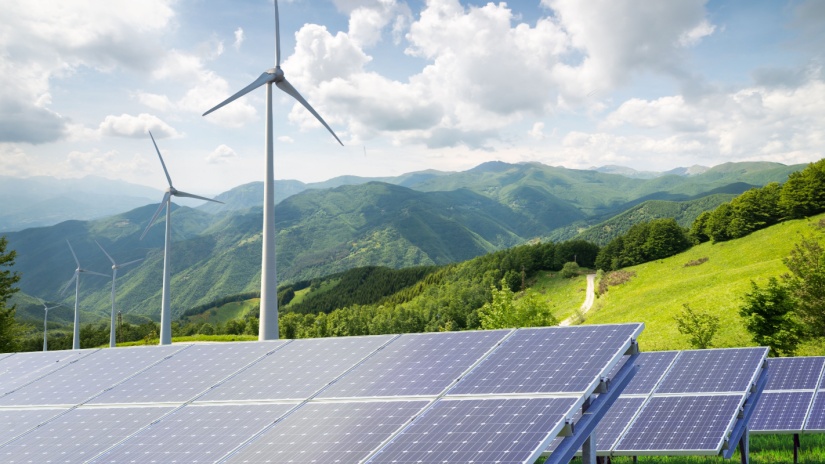Knowledge Centre
Wind farms in Australia

In 2022, 32% of Australia’s total electricity generation came from renewable energy sources, with 11% of that being wind power.
Wind power plays a crucial role in Australia's renewable energy sector. This method involves using turbines to capture wind energy and convert it into electricity through generators. Despite its benefits, such as being a clean and abundant energy source, wind power also has its challenges.
Along with solar power and hydropower, wind power is a major player and despite its visibility with large turbines in the outback, many are unfamiliar with how it actually works beyond the sight of spinning blades.
What is wind energy?
Wind energy is a centuries-old concept that harnesses the power of wind for various purposes. Initially used for sailing and milling, today, wind power is primarily used for generating electricity.
This is achieved through wind turbines, which resemble modern windmills and can usually be found either out to sea, or in large fields.
How does it work?
Wind power is created using wind turbines, which transform the wind's motion into electricity. These turbines have propellers at the top that catch the wind and spin gears connected to a generator.
This generator converts the spinning motion into electrical energy. Wind farms are often located in elevated areas because there is more wind at higher altitudes. Many wind turbines are built as tall as 160 metres to capture the stronger winds found at these heights.
Types of wind turbines
Wind turbines come in various types, each suited to different locations and applications:
Horizontal-axis turbines
These are the most common and are what we typically see on large wind farms. They have three blades attached to a horizontal shaft, and the entire turbine can rotate to face the wind for optimal energy capture.
Vertical-axis turbines
Unlike horizontal-axis turbines, vertical-axis turbines have blades that spin around a vertical axis. This design allows them to capture wind from any direction without needing to rotate the entire turbine.
Offshore wind turbines
These are the largest type of wind turbines and are installed in bodies of water such as oceans or lakes. They harness the strong, consistent winds over water to generate significant amounts of energy.
Utility wind turbines
These turbines are installed on land and are commonly seen in wind farms. They are grouped together in arrays to generate electricity for the grid, providing a sustainable energy source.
Small-scale wind turbines
These turbines are designed for residential, agricultural, or small-scale commercial use. They are typically under 100 kW in size and are used in remote or off-grid locations where traditional electricity sources are not available or reliable.
Each type of wind turbine has its advantages and is suited to different environments and energy needs.
Wind farms in Australia
In 2023, Australia will have 300+ wind farm projects, including operational, under construction, or proposed ones, larger than one megawatt (MW).
The wind farm landscape varies by state, ownership, and generation capacity, highlighting wind energy's growing importance and diversity across Australia. Let’s take a look at where you can find wind farms in Australia according to the ecogeneration Wind Map of Australia of 2023:
New South Wales
NSW currently has 16 operational wind farms with capacities exceeding 1MW, highlighting the state's commitment to wind energy.
As of 2023, three more farms are under construction, and an impressive 49 projects are in the proposal stage.
Queensland
In Queensland, wind farm development is still in progress, with only five operational wind farms exceeding 1 MW in capacity as of 2023.
However, Queensland also has at least 39 proposed projects and an additional four farms already under construction.
Victoria
Victoria stands out as a leader in wind energy, with 40 operational wind farms with a capacity exceeding 1MW.
Victoria is also witnessing further growth, with three new farms currently under construction and an impressive 39 projects in the proposal stage as of 2023.
South Australia
South Australia has 21 operational wind farms exceeding 1 MW in capacity. Additionally, the state has one farm under construction and 17 proposed projects.
Western Australia
Western Australia currently has 20 operational wind farms exceeding 1 MW in capacity. The state is also witnessing the construction of one wind farm, with 31 additional projects proposed.
Tasmania
Tasmania is gradually expanding its wind energy projects, with only five operational wind farms exceeding 1 MW in capacity.
However, the island state has 12 proposed wind farm projects, and one is already under construction as of 2023.
Pros and cons of wind energy
Wind energy, despite its long history of use, presents several challenges. One major concern is the substantial land clearing required for turbine installation, disrupting local wildlife habitats. Additionally, the noise and visual impact of turbines are often considered drawbacks.
However, wind power is a clean and renewable energy source that requires minimal ongoing maintenance once operational. It offers economic benefits to landowners, such as farmers, who can lease their land for turbine installation, boosting the local economy.
| Pros | Cons |
| Environmentally friendly and sustainable | Initial construction requires fossil fuels |
| High efficiency when located in optimal areas | Wind's variability can lead to intermittent power generation |
| Provides additional income for landowners | Land-intensive, potential disruption to ecosystems |
| Predictable energy production | Turbines can be considered ugly and generate noise pollution |
| Low operating costs after installation | High upfront costs and lengthy construction periods |
| Contributes to energy independence and security | Requires new infrastructure development compared to other renewables |
Are residential wind farms an option in Australia?
Residential wind power is a viable option for off-grid energy generation, but it may not always be practical. While small-scale wind turbines can be used in farms, remote communities, and off-grid homes, they often cannot generate enough electricity to meet all needs.
It's not possible to subscribe to wind power exclusively for your home. Electricity is generated from various sources like coal, solar panels, and hydropower plants, all contributing to the grid's electricity supply.
While you can support renewable energy by opting for GreenPower programs offered by certain electricity providers, the electricity you receive from the grid is a mix of all generation sources.
Before investing in off-grid residential wind turbines, it's essential to measure the wind speed on your property for a full year using an anemometer. This will help determine if wind turbines are a suitable option for your location.
You can still reduce your electricity costs without a wind-only system. If you're interested in lowering your energy bills, you can talk to our team at Compare Energy to find out if you could save money with a more affordable power plan.

